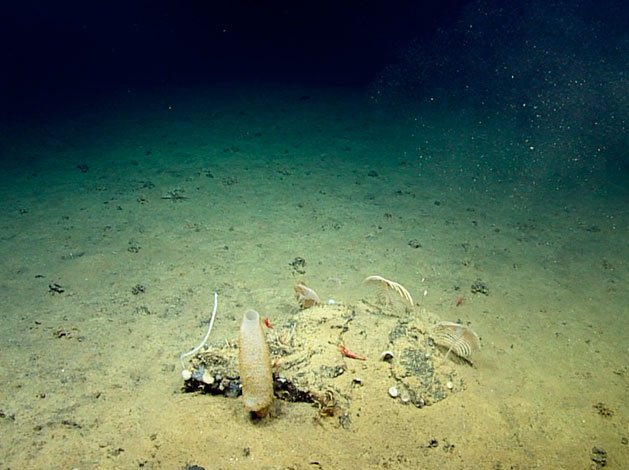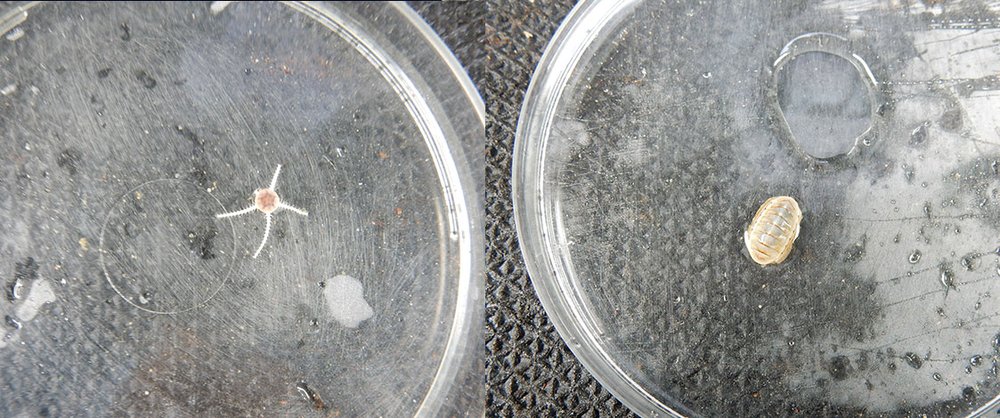The deep-sea is the largest biome on Earth, made up of marine habitats that exist below 200 m. This unexplored space is a heterogeneous landscape with underwater mountains, oceanic pits, marine caves as well as hypersaline and anoxic (low oxygen) environments (Duarte, 2006). Deep-sea habitats sustain unimaginable [DB1] life forms, from microorganisms to four-meter-long sharks, all of which have adapted to living in extreme conditions such as absolute darkness, immense pressure and very cold temperatures. While deep-sea environments remain the most understudied on the planet, recent technological advances have facilitated scientific explorations of these spaces, revealing that there is a world to discover.
While the Galapagos Marine Reserve (GMR) is globally famous for its marine biodiversity, like in the rest of the world, little is known about life beyond scuba diving depths. Nonetheless, thanks to several international oceanographic expeditions that took place recently, researchers of the Charles Darwin Foundation (CDF) are uncovering, little by little, what life looks like in these remote deep spaces.

Recently, during my internship at CDF, I had the unique opportunity to see and study life in marine ecosystems more than 1000 m deep. For three months, I was part of CDF’s team that leads the Characterizing Seamounts and Deep-sea Ecosystems in the Galapagos Marine Reserve project. My role involved assisting the management of samples and data collected during the Nautilus oceanographic expedition in 2015. In collaboration with Ocean Exploration Trust, CDF and the Galapagos National Park Directorate, remotely operated vehicles (ROVs) explored unchartered seamounts and lava flows at depths of 200 to 3400 m. The ROV manipulators collected samples and cameras captured video footage of the benthic (seafloor dwelling) flora and fauna, with the goal of obtaining data to produce the first biodiversity inventory for deep-sea ecosystems in the reserve.

I was in charge of the maintenance of over 300 deep-sea specimen samples and updating the inventory with recent identifications. During this time, I got to realize how studying and describing unknown ecosystems requires a lot of time and the support of a very large team. Since there are no local experts (in Galapagos or Ecuador) that can identify most of these species, the project collaborates with more than 20 taxonomists from all parts of the world, each specialized in a specific group of deep-sea organisms. I was impressed to learn that most of the organisms sampled that have been identified are new to the GMR, and almost 25% are new species for science. Being able observe and inspect the specimens was fascinating, as they come in all shapes and sizes, many resembling coastal species I am familiar with, but others were weird looking things I had never seen before!

I was particularly intrigued by these creatures called xenophyophores, which look like sponges but technically are not even an animal. Xenophyophores, which can reach up to 20 cm in size, are made up of multiple unicellular organisms that belong to the foraminifera phylum and congregate to form a fragile roundish shell-like structure made of organic matter “glued” together by a slime the cells produce (NOAA, 2005). The xenophyophores are detritivores, meaning they feed on the remains of organic matter in the sediment or water column, which they trap with arm-like projections that also enable them to move along the seafloor. Although they are fragile, the ROV managed to collect a xenophyophore sample while exploring a seamount near Darwin Island at a depth of 1338 m and temperature of ~ 3°C. In the ROV video footage I also observed that xenophyophores were very common at my of the sites explored, particularly on sandy seafloors at depths between 900 and 2000 m, often forming high density ”xenophyophore beds". According to Dr. Ole Secher Tendal, an expert taxonomist of foraminifera organisms, least 4 different xenophyophores genera are present in Galapagos, such as the genus Psammina.
Dr. Tendal pointed out that “the seabed of Galapagos appears to sustain an astounding abundance of xenophyophores, which is very interesting and of ecological importance”

Like corals, xenophyophores are habitat forming organisms and thus important in sustaining deep-sea biodiversity (Gooday et al 2017). In between the pores of their structure reside small invertebrates such as brittle stars, annelids and chitons. Furthermore, given their slow growth and fragile structures, making them very vulnerable to anthropogenic impacts such as marine mining and deep-sea fishing, xenophyophores are becoming classified as a bioindicator species for detecting disturbance events (Watling & Auster, 2017).

Currently, we still know very little about xenophyophores, for instance little is known about their reproduction process and life cycle, which underscores the value and importance of project like this. The Galapagos Marine Reserve hosts several ecosystems at different depths that have not yet been fully explored or studied, so there is still much to be done and new species to discover. Consequently, it is important to continue exploring and studying the deep-sea habitats of our unique reserve, which unlike other ocean spaces, is still in a close to pristine state. Such knowledge will not only be fascinating but valuable to decision makers who specify management priorities that define the protection of the marine resources of the Galapagos.
References:
Duarte, C. (2006). La exploración de la biodiversidad marina. (p. 8). Mallorca. Retrieved from www.fbbva.es
NOAA. (2005). NOAA Ocean Explorer: Xenophyophore. Retrieved April 18, 2019, from Oceanexplorer.noaa.gov
Watling, L., & Auster, P. J. (2017). Seamounts on the High Seas Should Be Managed as Vulnerable Marine Ecosystems. Frontiers in Marine Science, 4(January), 1–4. https://doi.org/10.3389/fmars.2017.00014




